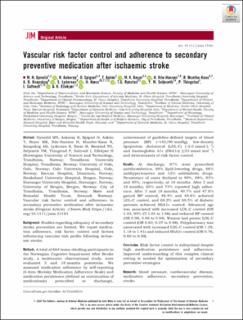Vascular risk factor control and adherence to secondary preventive medication after ischaemic stroke
| dc.contributor.author | Gynnild, Mari Nordbø | |
| dc.contributor.author | Aakerøy, Rachel | |
| dc.contributor.author | Spigset, Olav | |
| dc.contributor.author | Askim, Torunn | |
| dc.contributor.author | Beyer, Mona Kristiansen | |
| dc.contributor.author | Ihle-Hansen, Hege | |
| dc.contributor.author | Munthe-Kaas, Ragnhild | |
| dc.contributor.author | Knapskog, Anne Brita | |
| dc.contributor.author | Lydersen, Stian | |
| dc.contributor.author | Næss, Halvor | |
| dc.contributor.author | Røsstad, Tove Garåsen | |
| dc.contributor.author | Seljeseth, Yngve Müller | |
| dc.contributor.author | Thingstad, Pernille | |
| dc.contributor.author | Saltvedt, Ingvild | |
| dc.contributor.author | Ellekjær, Hanne | |
| dc.date.accessioned | 2021-03-17T13:19:21Z | |
| dc.date.available | 2021-03-17T13:19:21Z | |
| dc.date.created | 2020-08-05T09:01:43Z | |
| dc.date.issued | 2021 | |
| dc.identifier.issn | 0954-6820 | |
| dc.identifier.uri | https://hdl.handle.net/11250/2733945 | |
| dc.description.abstract | Background Studies regarding adequacy of secondary stroke prevention are limited. We report medication adherence, risk factor control and factors influencing vascular risk profile following ischaemic stroke. Methods A total of 664 home‐dwelling participants in the Norwegian Cognitive Impairment After Stroke study, a multicenter observational study, were evaluated 3 and 18 months poststroke. We assessed medication adherence by self‐reporting (4‐item Morisky Medication Adherence Scale) and medication persistence (defined as continuation of medication(s) prescribed at discharge), achievement of guideline‐defined targets of blood pressure (BP) (<140/90 mmHg), low‐density lipoprotein cholesterol (LDL‐C) (<2.0 mmol L−1) and haemoglobin A1c (HbA1c) (≤53 mmol mol−1) and determinants of risk factor control. Results At discharge, 97% were prescribed antithrombotics, 88% lipid‐lowering drugs, 68% antihypertensives and 12% antidiabetic drugs. Persistence of users declined to 99%, 88%, 93% and 95%, respectively, at 18 months. After 3 and 18 months, 80% and 73% reported high adherence. After 3 and 18 months, 40.7% and 47.0% gained BP control, 48.4% and 44.6% achieved LDL‐C control, and 69.2% and 69.5% of diabetic patients achieved HbA1c control. Advanced age was associated with increased LDL‐C control (OR 1.03, 95% CI 1.01 to 1.06) and reduced BP control (OR 0.98, 0.96 to 0.99). Women had poorer LDL‐C control (OR 0.60, 0.37 to 0.98). Polypharmacy was associated with increased LDL‐C control (OR 1.29, 1.18 to 1.41) and reduced HbA1c control (OR 0.76, 0.60 to 0.98). Conclusion Risk factor control is suboptimal despite high medication persistence and adherence. Improved understanding of this complex clinical setting is needed for optimization of secondary preventive strategies. | en_US |
| dc.language.iso | eng | en_US |
| dc.publisher | Wiley | en_US |
| dc.rights | Attribution-NonCommercial-NoDerivatives 4.0 Internasjonal | * |
| dc.rights.uri | http://creativecommons.org/licenses/by-nc-nd/4.0/deed.no | * |
| dc.title | Vascular risk factor control and adherence to secondary preventive medication after ischaemic stroke | en_US |
| dc.type | Journal article | en_US |
| dc.type | Peer reviewed | en_US |
| dc.description.version | publishedVersion | en_US |
| dc.rights.holder | Copyright 2020 The Authors. | en_US |
| cristin.ispublished | true | |
| cristin.fulltext | original | |
| cristin.qualitycode | 2 | |
| dc.identifier.doi | 10.1111/joim.13161 | |
| dc.identifier.cristin | 1821682 | |
| dc.source.journal | Journal of Internal Medicine | en_US |
| dc.source.pagenumber | 355-368 | en_US |
| dc.identifier.citation | Journal of Internal Medicine. 2021, 289 (3), 355-368. | en_US |
| dc.source.volume | 289 | en_US |
| dc.source.issue | 3 | en_US |
Tilhørende fil(er)
Denne innførselen finnes i følgende samling(er)
-
Department of Clinical Medicine [2066]
-
Registrations from Cristin [9791]

